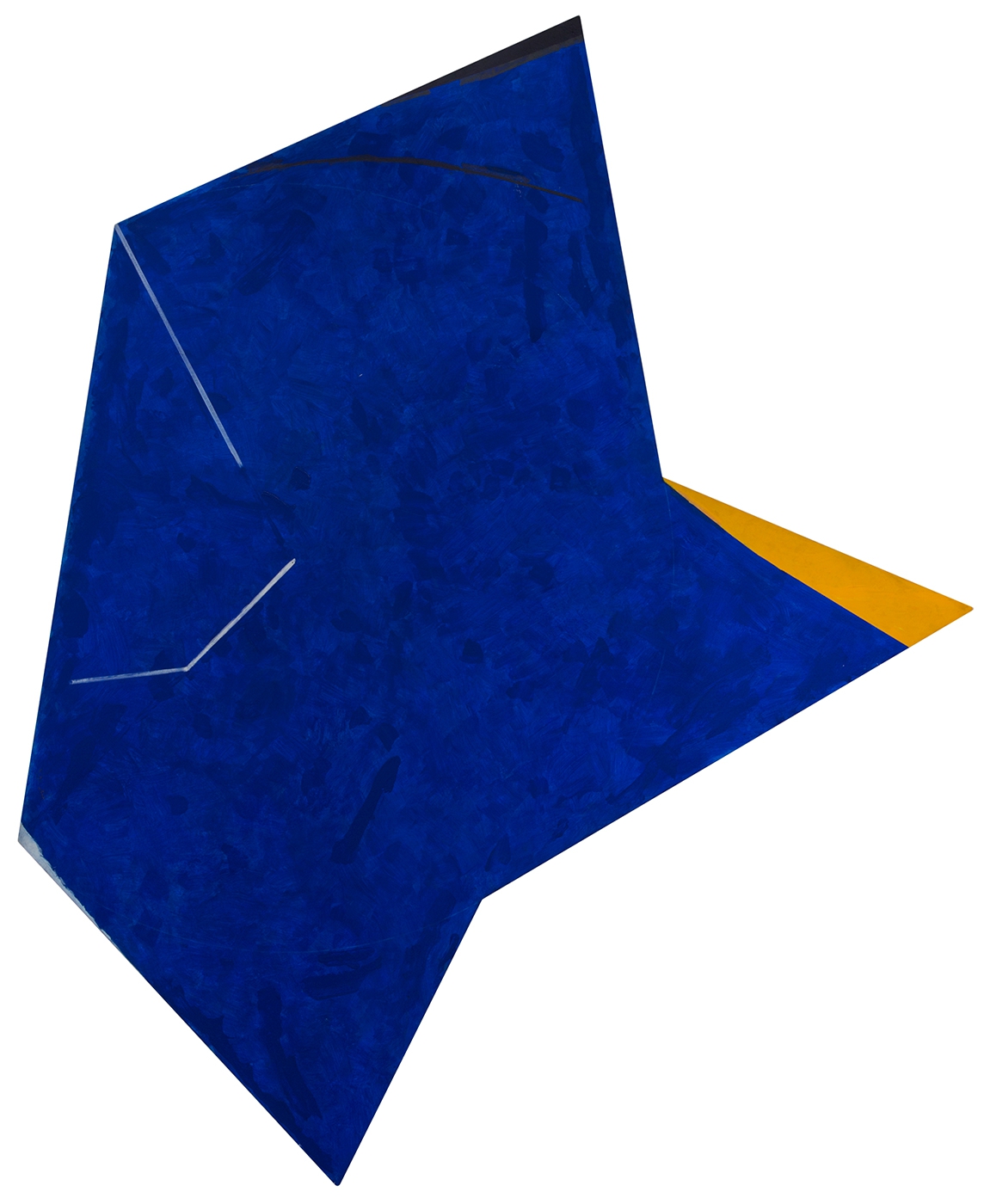Courtesy Galleria Gió Marconi, Milano
Nagjma in arabo significa stella. Ho cominciato questo lavoro in Marocco, forse la luce di Tangeri ha deciso il loro prendere forma, le decorazioni dell’architettura araba hanno suggerito questi segni.
In qualche modo raffigurano la sagoma della rappresentazione grafica convenzionale della stella.
Ma la stella è luce, non ha forma, è un punto di irraggiamento luminoso nel buio della notte.
La rappresentazione grafica della stella indica proprio, in forma di vettori, questo irraggiamento, la direzione dell’espandersi della luce verso l’ombra. Il confine di questo movimento che non ha un vero definito confine, disegna la forma della stella in tutte le rappresentazioni simboliche e decorative. Anche queste stelle, in questi quadri, indicano un movimento di fuga verso l’esterno, oltre il limite definito del margine, ma questo irradiamento il margine comunque trattiene e la pittura ne rimane catturata. Il lavoro di questi quadri, all’interno della figura ne definisce il confine, riguarda la superficie, in fondo cerca di saggiare la possibilità di una definizione centrifuga della superficie, una espansione dell’area del colore verso un impossibile fuori, il centro del quadro è il punto che genera la circonferenza intorno alla quale si delinea la stella, misura la distanza dai suoi margini, indica il luogo dell’inizio della pittura, della stesura, del suo distendersi in direzione del bordo fino a raggiungere un ciglio, un’invalicabile sponda al suo dispiegarsi.
Gianfranco Pardi, 1998
In Arabic nagjma means star. I started this work in Morocco: perhaps the light in Tangier decided their form, the decorations in Arab architecture suggested these signs.
They somehow picture the outlines of the conventional graphic representation of a star. But a star is light; it has no form; it is a point from which light is radiated into the darkness of the night.
The graphic representation of the star indicates this radiation in the form of the vectors pointing in the directions followed by the light as it expands into the darkness. The confines of this movement are not definite and design the shape of the star in all symbolic and decorative representations. The stars in these paintings also indicate an outwards, escaping movement, thrusting beyond the defined limit of the margin, although the margin actually does retain this radiation and the painting remains captured by it. The work in these paintings concerns the surface, it basically seeks to test the possibility of a centrifugal definition of the surface, an expansion of the area of colour towards an impossible outside. The centre of the painting is the point that generates the circumference around which the star is delineated, measuring the distance from its margins, indicating the place where the picture begins and the paint starts spreading towards the edge until it reaches a brink, an impassable limit to its further expansion.
Gianfranco Pardi, 1998

Courtesy Galleria Gió Marconi, Milano
Nagjma in arabo significa stella. Ho cominciato questo lavoro in Marocco, forse la luce di Tangeri ha deciso il loro prendere forma, le decorazioni dell’architettura araba hanno suggerito questi segni.
In qualche modo raffigurano la sagoma della rappresentazione grafica convenzionale della stella.
Ma la stella è luce, non ha forma, è un punto di irraggiamento luminoso nel buio della notte.
La rappresentazione grafica della stella indica proprio, in forma di vettori, questo irraggiamento, la direzione dell’espandersi della luce verso l’ombra. Il confine di questo movimento che non ha un vero definito confine, disegna la forma della stella in tutte le rappresentazioni simboliche e decorative. Anche queste stelle, in questi quadri, indicano un movimento di fuga verso l’esterno, oltre il limite definito del margine, ma questo irradiamento il margine comunque trattiene e la pittura ne rimane catturata. Il lavoro di questi quadri, all’interno della figura ne definisce il confine, riguarda la superficie, in fondo cerca di saggiare la possibilità di una definizione centrifuga della superficie, una espansione dell’area del colore verso un impossibile fuori, il centro del quadro è il punto che genera la circonferenza intorno alla quale si delinea la stella, misura la distanza dai suoi margini, indica il luogo dell’inizio della pittura, della stesura, del suo distendersi in direzione del bordo fino a raggiungere un ciglio, un’invalicabile sponda al suo dispiegarsi.
Gianfranco Pardi, 1998
In Arabic nagjma means star. I started this work in Morocco: perhaps the light in Tangier decided their form, the decorations in Arab architecture suggested these signs.
They somehow picture the outlines of the conventional graphic representation of a star. But a star is light; it has no form; it is a point from which light is radiated into the darkness of the night.
The graphic representation of the star indicates this radiation in the form of the vectors pointing in the directions followed by the light as it expands into the darkness. The confines of this movement are not definite and design the shape of the star in all symbolic and decorative representations. The stars in these paintings also indicate an outwards, escaping movement, thrusting beyond the defined limit of the margin, although the margin actually does retain this radiation and the painting remains captured by it. The work in these paintings concerns the surface, it basically seeks to test the possibility of a centrifugal definition of the surface, an expansion of the area of colour towards an impossible outside. The centre of the painting is the point that generates the circumference around which the star is delineated, measuring the distance from its margins, indicating the place where the picture begins and the paint starts spreading towards the edge until it reaches a brink, an impassable limit to its further expansion.
Gianfranco Pardi, 1998
Social
Contatti
archiviopardi@gmail.com